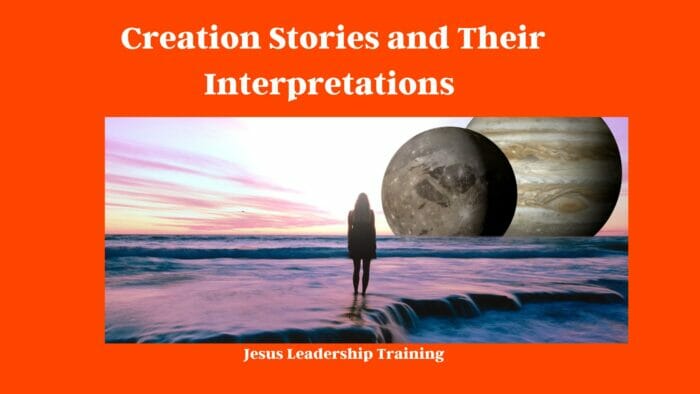Table of Contents
Introduction:
From time immemorial, mankind has looked towards the heavens and pondered over the mysteries of our existence. Every culture has its own unique creation stories and interpretations, serving as spiritual and philosophical cornerstones. This article delves into a multitude of these stories, teasing apart the threads of these complex narratives and presenting them in a palatable, engaging form.
1. “Creation Stories and Their Interpretations”: The Cradle of Civilization
Creation stories are more than mere tales; they are deep reflections of the societies from which they originate. By analyzing these stories, we can gain unprecedented insights into the cultural, philosophical, and spiritual foundations of these societies. From the cosmic egg of Chinese folklore to the dreamtime stories of the Australian Aboriginals, each tale provides a distinctive perspective on the nature of the universe.

1.1 Chinese Creation Myth: Pangu and the Cosmic Egg
According to Chinese mythology, the universe began as a chaotic, primordial mass, akin to a giant egg. Within this egg lay Pangu, the progenitor of all things. After 18,000 years, Pangu awoke, cleaved the egg with a mighty axe, thus separating the heavens from the earth.
1.2 Australian Aboriginal Dreamtime: The Rainbow Serpent
In stark contrast to the cosmic egg narrative, Aboriginal Australians view creation as a continuous process occurring within the “Dreamtime”. One popular creation story centers around the Rainbow Serpent, a powerful being who shaped the earth during her journey across it.
2. Native American Narratives: Exploring A Diversity of Perspectives
Native American tribes boast a rich array of creation stories, reflecting their deep connection with the natural world. While some stories share common themes, each is uniquely woven into the fabric of the tribe’s culture and beliefs.

2.1 The Hopi Creation Story: Spider Woman and the Emergence
In Hopi mythology, Spider Woman, along with her partner Tawa, are responsible for the creation of all life. Through the process of emergence, life transitions from one world to the next, driven by the need for spiritual evolution.
2.2 The Iroquois Creation Story: Sky Woman and Turtle Island
The Iroquois creation story speaks of the Sky Woman who fell from the celestial world onto the back of a giant turtle. This turtle’s back gradually became the Earth, known as Turtle Island in Iroquois culture.
3. African Mythologies: From the High God to the Divine Smith
African creation stories vary significantly across the continent. Some speak of a distant High God, while others recount tales of divine craftsmen fashioning the world.
3.1 The Dogon Myth: Nommo and the Order of the Universe
The Dogon people of Mali tell of Nommo, a primordial being dispatched by Amma, the supreme god, to bring order to the world.

3.2 The Yoruba Myth: Obatala and the Creation of Humanity
In Yoruba mythology, Obatala, a deity of the sky, descends to the chaotic earth to create the first humans, using a shell filled with sand and a divine chicken.
4. Biblical Creation Story: A Seminal Tale in Western Culture
The Genesis narrative of creation is perhaps the most well-known in Western culture. Over seven days, God created the world, and on the seventh day, He rested. This narrative has been subject to countless interpretations over centuries, bearing profound influence on Western thought and morality.
5. Creation Stories in Modern Interpretation: Evolution and Cosmology
As our scientific understanding evolves, we reinterpret ancient creation stories through the lens of modern cosmology and evolutionary biology. What were once seen as literal truths are now appreciated as metaphorical narratives, underlining the timeless relevance of these stories.
6. Common Themes in Creation Stories: Chaos, Order, and the Human Condition
Despite their geographical and cultural diversity, creation stories often share common themes: the emergence of order from chaos, the struggle of primeval beings, and the intrinsic value of the human experience. These themes resonate across cultures, reinforcing the notion of a shared human consciousness.
7. Creation Stories: Windows into Our Collective Psyche
In conclusion, creation stories are far from mere myths. They are powerful tools of introspection, offering glimpses into our collective psyche. As we peel back the layers of these narratives, we uncover not only the spirit of our ancestors but also the shared dreams and fears that bind us as a species.
FAQS:
- What are some common themes in creation stories across cultures?
- How does the Genesis narrative of creation influence Western culture?
- What insights can be gained from the Chinese creation myth of Pangu?
- How do modern interpretations of creation stories relate to scientific theories like evolution and cosmology?
- Can creation stories be considered as literal historical accounts?
- How do creation stories reflect the beliefs and values of the cultures from which they originate?
Conclusion:
Exploring creation stories and their interpretations offers us a deeper understanding of our shared human heritage. These tales, rich in symbolism and cultural nuance, serve as windows into the human soul, providing a backdrop for our collective existential quest. They remind us that while our cultures and experiences may vary, our quest for understanding the origins of the universe is a thread that binds us all.




